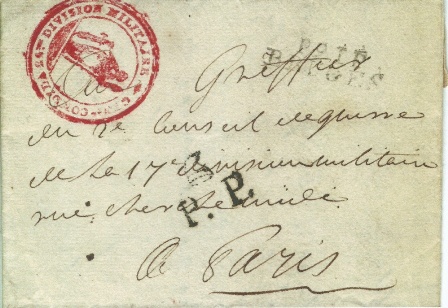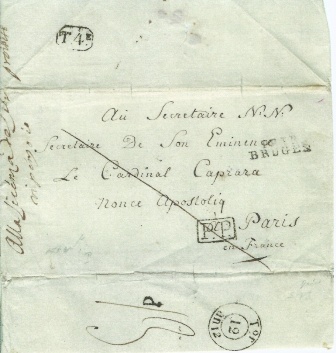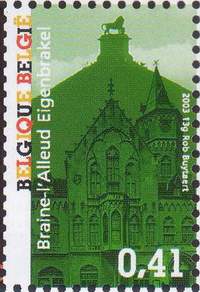Manifestations (préventes, bourses, etc...)
Exposition internationale et bureau temporaire Braphil '15
STEVENSON Iain, professor Académie Européenne de Philatélie
Postal History of Belgium from the French Revolution to the
Battle of Waterloo, 1789-1815
Prior to the French Revolution of 1789, the territory that was later to become Belgium was part of the Austrian Netherlands, and the postal arrangements were operated as a private enterprise by the Princely house of Thurn and Taxis which was headquartered in Brussels with routes to Antwerp, to England, France, Germany and Spain.
 The revolutionary fervour that gripped France spread into the Netherlands and similar uprising occurred there. Shown in this display is a letter from the short-lived Brabantine Republic and various military letters as French forces moved into the area. Under First Consul, Napoleon Bonaparte, the French took over much of the Austrian territory. The territory was first administered as occupied land by the military and was later incorporated into the French Republic and Empire as départements conquis, where French governance and structures were imposed.
The revolutionary fervour that gripped France spread into the Netherlands and similar uprising occurred there. Shown in this display is a letter from the short-lived Brabantine Republic and various military letters as French forces moved into the area. Under First Consul, Napoleon Bonaparte, the French took over much of the Austrian territory. The territory was first administered as occupied land by the military and was later incorporated into the French Republic and Empire as départements conquis, where French governance and structures were imposed.
Official Letter from Bruges to Paris, dated 21 Messidor Year 7 (9 July 1799). 9 décimes paid in advance. P91P BRUGES dispatch mark for a pre-paid letter. Cachet of the 26th Military Division in red with standing revolutionary Goddess. P.P. (post payé) receipt mark of Paris with Phrygian or revolutionary bonnet.
As far as postal arrangements were concerned, the Thurn and Taxis system was suppressed and the Prince and his entourage expelled from Brussels. French procedures, rates and systems were introduced, including the use of departmental numbers in postmarks, and the use of the Déboursé system to reclaim postage on forwarded and undeliverable letters, and the introduction of French currency.
 The French administration was pervasive and thorough, and although it was introduced quickly, it proved efficient and offered correspondents a reliable, regular and trustworthy service for the sending of both commercial and personal letters. Even after the defeat of Napoleon at Waterloo, its structures remained the basis of the mail system operated in Belgium both under the Dutch and Belgian kingdoms after 1815 and 1830.
The French administration was pervasive and thorough, and although it was introduced quickly, it proved efficient and offered correspondents a reliable, regular and trustworthy service for the sending of both commercial and personal letters. Even after the defeat of Napoleon at Waterloo, its structures remained the basis of the mail system operated in Belgium both under the Dutch and Belgian kingdoms after 1815 and 1830.
The new departmental organisation of the territory comprised nine units : 86 Jemappes, chief town Mons ; 91 La Lys, chief town Bruges ; 92 l’Escaut, chief town, Liège ; 97 Sambre-et-Meuse, chief town Namur. Two départments, 95 La Meuse Inferieure based at Maastrich, and 98 Les Forêts, based at Luxembourg, included lands that would subsequently become Belgium.
Particularly interesting is a papal faculty written in Latin from Bruges to the Cardinal who would later arrange for the coronation of Napoleon as Emperor of the French in 1808, an event which would inevitably lead to his defeat on the field of Waterloo. Also note the use of the French Revolutionary calendar in the dates of letters, and the use of the form of address “Citoyen” (Citizen) both of which disappeared in the period after 1808 when the old republican ideals vanished to be replaced by the grandiose if short-lived Imperial dreams of Bonaparte.
Cover from Bruges to Paris enclosing a Papal faculty in Latin (also shown) Addressed to the secretary of the Papal nuncio in Paris, Cardinal Battista Caprara (1733-1810), dated 12 Thermidor Year 12 (31 July 1804).Rated at 13 décimes. Note handstruck “ d “ and postage rate on reverse.

